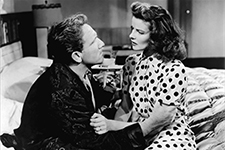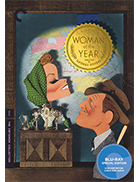Woman of the Year
|  For several years now, a supposed extract from a 1950s Home Economics textbook has been circulating social media and various Internet forums. Titled “Tips to Look After Your Husband,” it offers a retro-Eisenhower-era Ten Commandments for servile stay-at-home wives to make sure their hard-working husbands are fully taken care of, which include having dinner ready for him as soon as he walks in the door, making sure you and the children look good, minimizing noise, and not complaining about, well, pretty much anything. This extract, although circulated as a genuine historical artifact, is actually a fiction, having been created by the Scottish writer William McIlvanney for a 1998 essay he wrote for Glasgow’s The Herald titled “Fairy Tale of a Wife in Sheep’s Clothing.” But, no matter—there are elements of truth in McIlvanney’s clever fiction, and the manner in which it has been recycled and circulated online as evidence of the simultaneously amusing and alarming nature of gender dynamics 70 years ago is testament to their continued relevance. And speaking of relevance, what, you might be asking at this point, does any of that have to do with George Stevens’s progressive romantic comedy Woman of the Year, which is best known as the first on-screen pairing of Katharine Hepburn and Spencer Tracy, who would go on to star opposite each other in eight more films, including Tracy’s last role in Guess Who’s Coming to Dinner? (1967)? Nothing really, except that those purported tips for subservient wives that have come to embody the idea of how women were supposed to act in an earlier era have absolutely no place in the life of the film’s protagonist, Tess Harding (Katharine Hepburn). A highly educated (she went to school in Switzerland and the Sorbonne), multi-lingual, extremely well connected, and powerful New York newspaper columnist, Tess has little time for interpersonal relationships, much less fetching a pillow for her husband’s feet at the end of the day. As the daughter of a wealthy statesman (Minor Watson), her entire life has been spent mixing and mingling with political elites, and she is much more comfortable barking order at her compliant male secretary (Dan Tobin) or chatting with dignitaries in one of the numerous foreign tongues she speaks than listening to a husband’s gripes about his day at the office. However, that doesn’t stop Sam Craig (Spencer Tracy), a sports columnist who works for the same New York daily, from falling in love with her and proposing, which creates a perfectly dysfunctional marriage in which Tess puts literally everything—politics, events in Europe, giving speeches and winning awards—before their relationship. Sam is a perfectly ordinary American guy—full of fundamental decency and a love of baseball—which makes him irresistible to Tess, who otherwise couldn’t be bothered with romance, much less marital commitment. If he is something of a statue—predictable, simple, slightly weathered, but utterly solid—she is a blur, always in motion both physically (she travels all over the country and the world, sometimes at a moment’s notice) and emotionally. He doesn’t want to thwart her ambitions or her career, but at the same time he does want to be a part of her world, and from the very beginning he is cast aside (what he thinks will be their first date turns out to be a cocktail party at her penthouse apartment attended by people whose languages he does not speak and their wedding night is interrupted by the arrival of a European statesman recently escaped from a concentration camp). Thus, the traditional gender dynamics are flipped on their head, with the man in the relationship pining for the woman to slow down and notice him. In that sense, Woman of the Year was a surprisingly progressive film in terms of its depiction of a career woman who essentially holds all the power until she realizes how much else she is missing. The film’s third act, however, takes a massive step back in a more conventional direction, essentially punishing Tess for her casual self-absorption before finding in the last few minutes a place of common ground between Sam’s desire to be desired and Tess’s need to be in the middle of things. Before they get there, though, there is a protracted slapstick sequence in which Tess, in a bid to win Sam back, attempts to make him breakfast, an honest stab at domesticity that goes wrong in every conceivable way. There is something sweet and funny about Tess’s determination to make coffee and waffles even as it becomes patently clear that she has absolutely no idea what she is doing in a kitchen. Having grown up wealthy and privileged, she has never had to so much as toast her own toast (although the film’s suggestion that she doesn’t know how a toaster works pushes credulity). Yet, at the same time, the scene is an awkwardly placed attempt to undercut Tess’s authority as a character, and it doesn’t quite work (it is not surprising to learn that this scene was added after the film had wrapped and test audiences didn’t like the original ending). Yet, the film as a whole is frequently marvelous, if only for the way it documents the growing affection between Tracy and Hepburn (who would become off-screen romantic life partners until his death in 1967). Although director George Stevens is not remembered primarily for his comedies, he made a number of them in the pre-war years, including Penny Serenade (1941) and The More the Merrier (1943), as well as musicals like the Fred Astaire-Ginger Rogers vehicle Swing Time (1936) and the adventure movie Gunga Din (1939). Stevens had worked in the late 1920s with the comic duo Laurel & Hardy, from whom, according to biographer Marilyn Ann Moss, he learned about the centrality of humanity and vulnerability to good comedy, which is on ample display in Woman of the Year. Hepburn’s performance is crucial, as Tess is a potentially dislikable character whose self-absorption risks being off-putting, even as it is central to the narrative. She bounces her chiseled energy off Tracy’s stolid, but nuanced everyman, and their chemistry is palpable. Tracy was near the height of his stardom, having recently won back-to-back Oscars in 1937 and 1938, and Hepburn was in the midst of a career resurgence following the success of The Philadelphia Story (1940). It’s not surprising that she pushed this film—with its direct interrogation of female professionalism—into production and personally selected Stevens, who had recently made a number of “women’s films” with the likes of Irene Dunne and Jean Arthur. Woman of the Year isn’t necessarily one of the best films of its era, but it does capture in its essence the complex nature of relationships and the unavoidable way that power dynamics can come to a head.
Copyright © 2017 James Kendrick Thoughts? E-mail James Kendrick All images copyright © The Criterion Collection | |||||||||||||||||||||||||||||||
Overall Rating: 

 (3)
(3)


